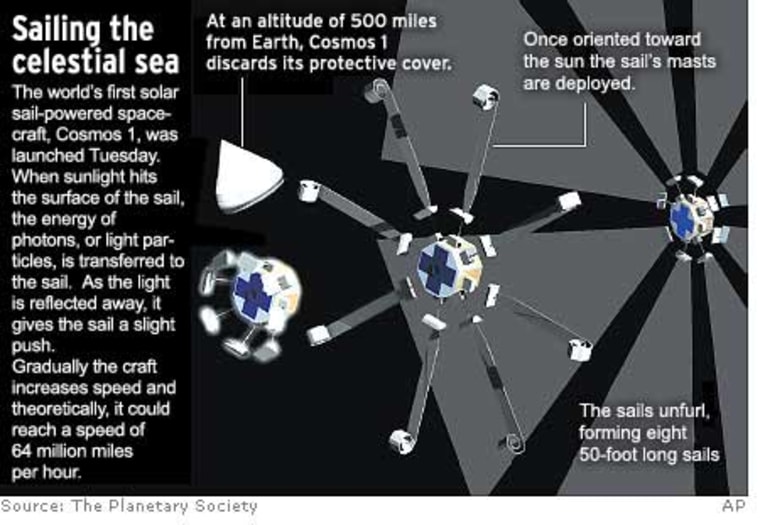An attempt to launch the world’s first solar sail spacecraft fizzled when a booster rocket failed less than two minutes after liftoff, Russian and U.S. space officials said Wednesday.
The Cosmos 1 vehicle, a joint Russian-American project, was intended to show that a solar sail can make a controlled flight. Solar sails are envisioned as a potential means for achieving interstellar flight, allowing spacecraft to gradually build up great velocity and cover large distances.
But the Volna booster rocket failed 83 seconds after its Tuesday launch from a Russian nuclear submarine in the Barents Sea, the Russian space agency said.
“The booster’s failure means that the solar sail vehicle was lost,” spokesman Vyacheslav Davidenko told The Associated Press. “The Russian navy is searching the area for the debris of the booster and the vehicle.”
A spokesman for the U.S. Strategic Command, Air Force Capt. Jeff Jones, told MSNBC.com on Wednesday that the Air Force Space Command's worldwide radar net had picked up no trace of the Cosmos 1 payload.
In the hours after the launch, mission managers at the California-based Planetary Society were still holding out hope that some monitoring stations had picked up faint signals from the $4 million spacecraft and that the craft had made it to orbit. Later, the society conceded in a statement that if the rocket failed during first-stage firing, then “this would mean that Cosmos 1 is lost.”
Nevertheless, mission managers said they would keep checking the tracking data — and they urged amateur skywatchers to keep looking as well. In a series of Internet postings, satellite-spotters reported seeing no sign of the craft.
Davidenko dismissed suggestions that the spacecraft might have reached orbit as “wishful thinking.”
“The failure of the first stage engine of the three-stage booster rocket has left no chance for the vehicle to reach orbit,” he told the AP, adding that fragments of the booster and the vehicle crashed into the sea.
A Russian government panel will investigate the failure, Davidenko said.

The solar sail vehicle weighed about 240 pounds (110 kilograms) and was designed to go into an orbit more than 500 miles (800 kilometers) high. It was designed to be powered by eight 50-foot-long sail (15-meter-long) structures resembling the blades of a windmill.
Each blade had been designed to turn to reflect sunlight in different directions so that the craft could “tack,” much like a sailboat in the wind.
The privately funded project was organized by the Planetary Society, which counts the late astronomer Carl Sagan as one of its founders. Funding came largely from Cosmos Studios, a science-based entertainment company that was founded by Sagan’s widow, Ann Druyan. Russia’s Lavochkin research production institute built the vehicle.
Lidiya Avdeyeva, a spokeswoman for the Lavochkin institute, said she could not comment on the failed launch because the Russian military officials who oversaw it had yet to provide technical details.
Lavochkin, a premier manufacturer of space probes that made interplanetary forays in the heyday of the Soviet space program, has struggled to survive after generous state funding withered following the 1991 Soviet collapse.
A litany of failures
Past attempts to unfold similar devices in space have failed.
In 1999, Russia launched a similar experiment with a sun-reflecting device from its Mir space station, but the deployment mechanism jammed and the device burned up in the atmosphere.
In 2001, Russia tried again, but the device failed to separate from the booster and burned in the atmosphere.
The botched launch of the solar vehicle was the second failure of a Russian booster rocket in just one day. Earlier Tuesday, the Molniya-M rocket carrying a military communications satellite failed shortly after its liftoff from a northern launch pad and fell over Siberia.
Yet another experimental spacecraft, the European Space Agency's Demonstrator-2R, is to be launched on a Russian Volna rocket next month. The mission will test technologies for future inflatable re-entry vehicles. It was not immediately clear whether the apparent failure of Cosmos 1 would hold up the Demonstrator-2R’s launch.
Cosmos 1 is far from the first satellite to be shot into space and then disappear while teasing ground observers for days or weeks. A top-secret U.S. Navy project called "Notsnik" fired small satellites spaceward from airplanes in 1958, and at least one launch is widely believed to have made it into orbit, based on sporadic radio contacts. Space radar tracking was in its infancy, and no independent confirmation was ever possible.
The first Air Force "Discoverer" satellite in 1959 is still officially listed as having achieved orbit, but according to historian and space policy expert Dwayne Day, it was all a myth. In an e-mail to MSNBC.com, Day said that because the Air Force had already issued a press release stating that Discoverer 1 was in orbit, a couple of junior officers were ordered to prove that the spacecraft was indeed in orbit. Over the next few days, they looked at information taken from several listening sites around the world, trying to find data that confirmed the vehicle's signals had been detected.
“They then reported to their superiors that Discoverer 1 was indeed in orbit,” Day wrote. “but they never really believed it.” Day said the officers privately concluded that the rocket didn't have enough power to reach orbit, and the spacecraft probably crashed into Antarctica.
In 1995, the Russian-built, German-funded Express 1 satellite was launched on a Japanese rocket, but then disappeared. It actually did circle Earth several times before its recoverable capsule landed in northern Ghana. Since nobody was looking for it, the local villagers stored it and sent out inquiries, and when the owners finally came to pick it up, they were presented with a storage fee large enough to build the village a new schoolhouse.
This report includes information from The Associated Press and NBC News space analyst James Oberg.
